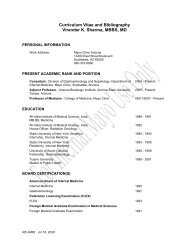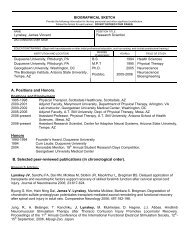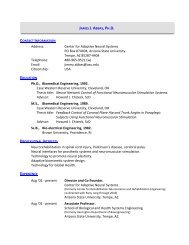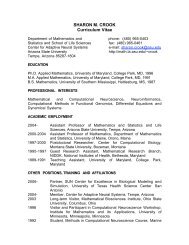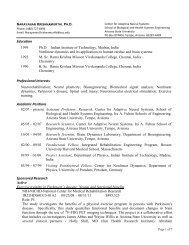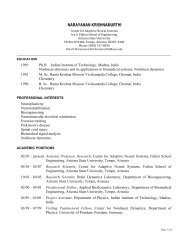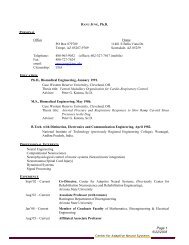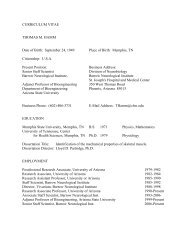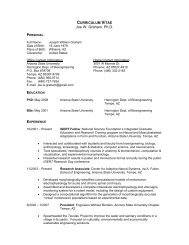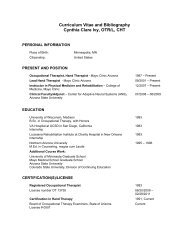ASU FC S 04 - Center for Adaptive Neural Systems - Arizona State ...
ASU FC S 04 - Center for Adaptive Neural Systems - Arizona State ...
ASU FC S 04 - Center for Adaptive Neural Systems - Arizona State ...
Create successful ePaper yourself
Turn your PDF publications into a flip-book with our unique Google optimized e-Paper software.
Faculty & Research News<br />
Annihilating Alzheimer’s<br />
Thanks to the continuing<br />
development of modern<br />
medicine, the average<br />
human life expectancy is<br />
well into one’s seventies;<br />
however, more than 10<br />
percent of the population<br />
over the age of 65 and<br />
more than 30 percent of<br />
the population over the<br />
age of 85 becomes<br />
afflicted with Alzheimer’s<br />
disease.<br />
“Alzheimer’s is a very debilitating disease,”<br />
said Michael Sierks, associate professor in<br />
chemical engineering in the Ira A. Fulton<br />
School of Engineering, “The person loses the<br />
ability to function normally—their ability to<br />
communicate, their spatial orientation, and<br />
their memory are gone—it’s very hard on<br />
them and their family.”<br />
Sierks’ interest in the disease stemmed from<br />
first hand experience within his own family.<br />
While he was reading up on Alzheimer’s <strong>for</strong><br />
personal knowledge, he discovered how<br />
applicable his background in protein engineering<br />
would be to neurodegenerative disease<br />
research.<br />
“It’s an engineering approach to biomedical<br />
research,” said Sierks.<br />
The exact cause of Alzheimer’s has yet to be<br />
discovered. Why some people develop the disease<br />
and others don’t is still a major debate in<br />
the research and scientific community. There<br />
are, however, two leading pathological culprits<br />
involving naturally produced proteins inside<br />
the body. The beta-amyloid and tau proteins,<br />
found normally in healthy people, aggregate<br />
and misprocess to <strong>for</strong>m what are called amyloid<br />
plaques and neurofibrillary tangles. These<br />
anomalies are found in abundance inside the<br />
brain of an Alzheimer’s patient. It is not<br />
known whether these protein aggregates<br />
specifically cause the disease, but it is agreed<br />
they play a major role in its progression.<br />
Sierks’ research focuses on developing antibodies<br />
that will prevent the <strong>for</strong>mation of the<br />
plaques. He is exploring different methods of<br />
attacking the proteins be<strong>for</strong>e they reach a<br />
toxic level by focusing on two different<br />
Warren Marcus is a postdoctoral researcher assisting Michael Sierks in<br />
eradicating the scourge of Alzheimer's through antibody-based therapeutics.<br />
approaches: the creation of bound antibodies<br />
that prevent aggregation, and the creation of<br />
catalytic antibodies that will break apart the<br />
proteins. Sierks is currently testing these<br />
methods in vitro and preliminary results have<br />
yielded positive results, encouraging Sierks to<br />
While reading up on<br />
Alzheimer’s <strong>for</strong><br />
personal knowledge,<br />
Sierks discovered how<br />
applicable his<br />
background in protein<br />
engineering would be to<br />
neurodegenerative<br />
disease research.<br />
get ready <strong>for</strong> the next step, which will be<br />
broadening his research into animal models to<br />
develop more specific and stable antibodies.<br />
As with AIDS, there is not likely to be one<br />
single cure <strong>for</strong> Alzheimer’s disease.<br />
“In the way of therapeutics,” said Sierks, “I<br />
think we’re going to find that a little bit of<br />
each treatment method is going to work better<br />
than a lot of just one.”<br />
Sierks is collaborating with other research<br />
facilities such as Sun Health Research in<br />
Phoenix and the Wadsworth <strong>Center</strong> in New<br />
York, and with the School of Life Sciences at<br />
<strong>ASU</strong>. Sierks is expanding his research to<br />
treating Parkinson’s and Huntington<br />
Diseases, two other protein-based neurodegenerative<br />
diseases.<br />
For more in<strong>for</strong>mation, you can<br />
contact Michael Sierks directly at<br />
Sierks@asu.edu<br />
IRA A. FULTON SCHOOL OF ENGINEERING – SPRING 20<strong>04</strong> 19



